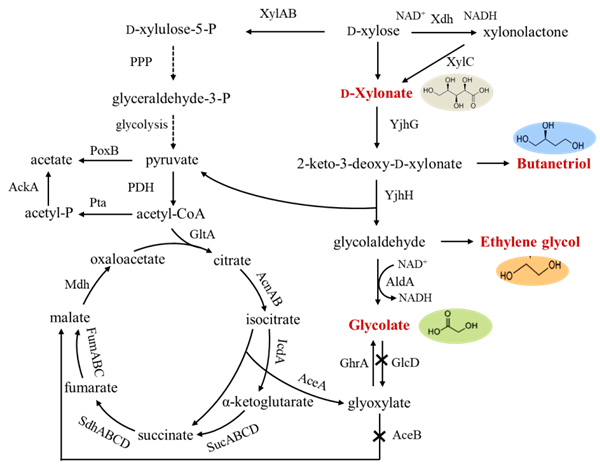Lignocellulosic biomass, refers to plant dry matter, is the most abundant and low-cost renewable resource on the planet. Xylose is the second most abundant sugar in nature which accounts for 18–30% of sugar in lignocellulose. Hence, efficiently metabolize xylose could optimize the economics of lignocellulose-based bio-refinery processes. In fact, only a small fraction of microorganisms has the native metabolic pathway of xylose.
Recently, a research team led by Prof. ZHAO Guang from Qingdao Institute of Bioenergy and Bioprocess Technology (QIBEBT), Chinese Academy of Sciences (CAS) achieved the high-value chemicals of glycolate and ethylene glycol from xylose in Escherichia coli.
Escherichia coli is a good choice as a host for xylose utilization due to its low cultivation cost, high growth rate, simple genetic manipulation and the native xylose metabolic pathway. However, the native xylose metabolic pathway of E. coli is so long and consumes much energy, which may affect the conversion efficiency. In contrast, a new metabolic pathway of xylose in Caulobacter crescentus just compensates for these problems. Therefore, the new synthetic pathways for glycolate and ethylene glycol in E. coli were constructed by introducing this new metabolic pathway of C. crescentus.
Finally, in the fed-batch cultivation, the engineered strain produced 43.60 g/L glycolate, with 0.91 g/L/h productivity and 0.46 xylose yield. The titer of ethylene glycol was 72 g/L with 1.38 g/L/h productivity and 0.40 xylose yield. The titer and productivity were more than twice as high as the current level, and the yield was close to the theoretical value. The researches will enrich the range of products from xylose, increase the xylose conversion efficiency and lay the foundation for the industrial application of bio-refinery of xylose.
The related results were published in Microbial Cell Factories. This project was supported by the National Natural Science Foundation of China, the key project of the Chinese academy of sciences and the China Postdoctoral Science Foundation.

Figure: The metabolic pathways of xylose for conversion of high-value chemicals. (Image by LIU Min)
(Text by LIU Min)
Contact:
Prof. ZHAO Guang, Ph.D.,
Qingdao Institute of Bioenergy and Bioprocess Technology, Chinese Academy of Sciences
Tel: 86-532-80662767
E-mail: zhaoguang@qibebt.ac.cn